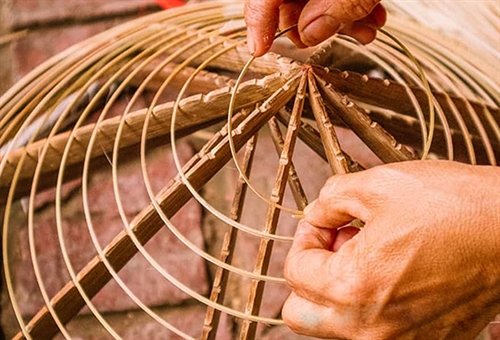Over the past 300 years, local people in Phu Gia village have been keeping and developing their traditional conical-hat-making handicraft, highlighting the cultural identity of Binh Dinh province.


In Phu Gia hamlet, Cat Tuong commune, Phu Cat district, Binh Dinh province, this couple dedicated more than half of their lives to producing horse conical hats (in Vietnamese: “Nón ngựa”). Video by Phong Vinh.

The population of Binh Dinh takes great pride in its horse conical hats. They first debuted over three centuries ago and served as imperial officials’ necessary accouterments. No one was certain who invented the hat originally, according to Mr. Do Van Lan (a Phu Gia peasant), who has over 55 years of expertise producing horse conical hats.

A hat may be made in 10 primary phases and 4 auxiliary processes. We may have to modify specific patterns in accordance with client requests. Therefore, the most time-consuming stage is embroidering designs, according to Mr. Lan.

Three primary components—bamboo (for hoops and frames), palm leaves (for covering the hat, also known as the roof), and pineapple roots—are required to produce one full horse conical hat (for threats). These resources are all accessible in Binh Dinh because of the excellent natural surroundings.

Embroidery threads, little nylon threads, big nylon threads, and other materials are also necessary. photographed in Ho Chi Minh City. Making horse hats requires a lot of time, work, and several intricate stages, according to Mrs. Tam (Mr. Lan’s wife), who has over 40 years of experience in the industry.

On the hat, artists frequently embroider designs like flowers, leaves, peacocks, dragons, turtles, birds, and more. People often use a five-colored pom-pom as decoration as the top of the hat is not entirely covered in leaves. On top of these hats is an iron lozenge-shaped cover with intricately carved motifs made of copper or silver.

Depending on its quality, a Phu Gia village horse conical hat can cost anywhere between VND 50.000 and VND 100.000. The price of a traditional prototype one might exceed VND 400.000.
The province People’s Committee designated five traditional craft villages in connection with the growth of tourism, including the hat-making village of Phu Gia. Since tourists have been discovering this artisan hamlet more often over the past few years, the inhabitants’ ability to support their families by manufacturing hats has improved.
You may take the 1A route from the Quy Nhon city center to Phu Gia hamlet, turn right onto the 19B road, continue for another 18 km, and then turn left onto the DT635 route. There, you must ask locals for directions to Phu Gia Village.
